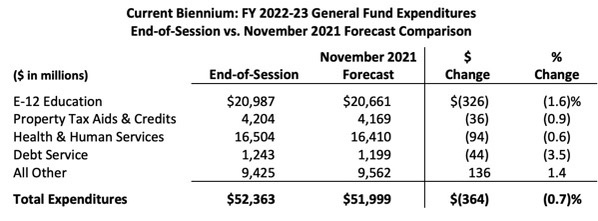A look into Minnesota’s record-setting budget surplus
On Dec. 7, the Minnesota Management and Budget (MMB) announced that Minnesota is expecting a $7.75 billion surplus for the 2022-2023 biennium. According to MMB, “Strong growth in income, consumer spending and corporate profits drove extraordinary revenue growth in FY 2021, and higher tax receipts to date in FY 2022 combine with an improved outlook for income, consumer spending, and corporate profits to raise the revenue forecast for the current biennium.”
While spending is down, it is only down slightly, and only accounts for a small portion of the surplus.

How big is the surplus?
Let us put things into perspective.
This is Minnesota’s largest budget surplus in history.
Based on 2020 population numbers, the Minnesota government will collect an extra $1,400 per Minnesotan and more than $3,500 per household in taxes compared to what they need for spending.
The surplus is about 15 percent of the 2022-2023 spending budget, which is currently forecasted at about $52 billion.

Even after taking out the $2.941 billion surplus already in the bank from the 2020-2021 fiscal year, the 2022-2023 biennium surplus is forecasted at $5.130 billion, about 10 percent of total expenditure and 10 percent more than the February forecast.
The budget surplus does not include the federal stimulus money balance, which currently stands at $1.1 billion.
If the state government used some part of the surplus to pay for the federal unemployment debt, it would still have more than $6.5 billion left over, not to mention an additional $1.1 billion in federal funds unspent.
In short, our state is flush with cash and is expecting to collect even more.
Compared to other states
Is this a unique trend? The short answer is no.
Other states have also seen favorable tax revenue trends. Minnesota is not unique in that sense. However, what is unique about Minnesota is our high taxes. As the state economist, Laura Kalambokidis explains, Minnesotans have a “tax revenue system that [is] well situated to capture tax receipts from the extraordinary growth.”
In other words, it is thanks to our progressive individual tax income, high corporate income tax , and general sales that the state government will collect the biggest surplus in our history for the next biennium.
The state government needs to give that money back to hardworking Minnesotans, as numerous other states have done with their surplus. There is no need to increase spending at a time when the state government is already spending more –– in real terms –– than at any other point in history.